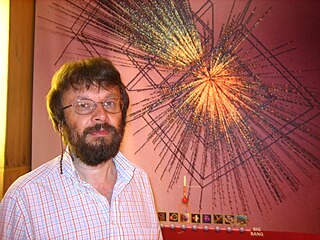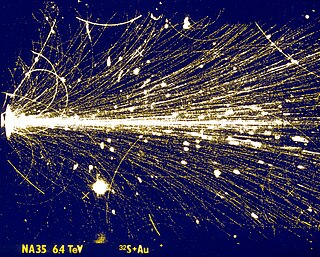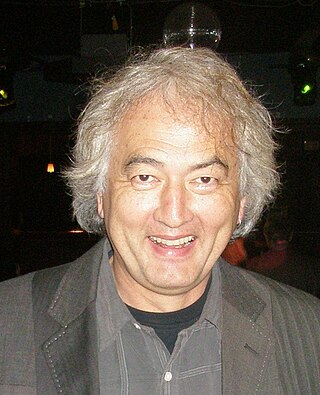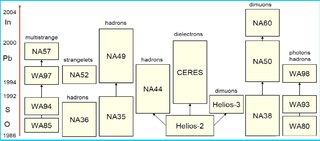Related Research Articles

A gluon is a type of massless elementary particle that mediates the strong interaction between quarks, acting as the exchange particle for the interaction. Gluons are massless vector bosons, thereby having a spin of 1. Through the strong interaction, gluons bind quarks into groups according to quantum chromodynamics (QCD), forming hadrons such as protons and neutrons.

The Relativistic Heavy Ion Collider is the first and one of only two operating heavy-ion colliders, and the only spin-polarized proton collider ever built. Located at Brookhaven National Laboratory (BNL) in Upton, New York, and used by an international team of researchers, it is the only operating particle collider in the US. By using RHIC to collide ions traveling at relativistic speeds, physicists study the primordial form of matter that existed in the universe shortly after the Big Bang. By colliding spin-polarized protons, the spin structure of the proton is explored.

High-energy nuclear physics studies the behavior of nuclear matter in energy regimes typical of high-energy physics. The primary focus of this field is the study of heavy-ion collisions, as compared to lighter atoms in other particle accelerators. At sufficient collision energies, these types of collisions are theorized to produce the quark–gluon plasma. In peripheral nuclear collisions at high energies one expects to obtain information on the electromagnetic production of leptons and mesons that are not accessible in electron–positron colliders due to their much smaller luminosities.
Hadronization is the process of the formation of hadrons out of quarks and gluons. There are two main branches of hadronization: quark-gluon plasma (QGP) transformation and colour string decay into hadrons. The transformation of quark-gluon plasma into hadrons is studied in lattice QCD numerical simulations, which are explored in relativistic heavy-ion experiments. Quark-gluon plasma hadronization occurred shortly after the Big Bang when the quark–gluon plasma cooled down to the Hagedorn temperature when free quarks and gluons cannot exist. In string breaking new hadrons are forming out of quarks, antiquarks and sometimes gluons, spontaneously created from the vacuum.

The STAR detector is one of the four experiments at the Relativistic Heavy Ion Collider (RHIC) in Brookhaven National Laboratory, United States.
Quark matter or QCD matter refers to any of a number of hypothetical phases of matter whose degrees of freedom include quarks and gluons, of which the prominent example is quark-gluon plasma. Several series of conferences in 2019, 2020, and 2021 were devoted to this topic.
In high-energy physics, jet quenching is a phenomenon that can occur in the collision of ultra-high-energy particles. In general, the collision of high-energy particles can produce jets of elementary particles that emerge from these collisions. Collisions of ultra-relativistic heavy-ion particle beams create a hot and dense medium comparable to the conditions in the early universe, and then these jets interact strongly with the medium, leading to a marked reduction of their energy. This energy reduction is called "jet quenching".

Quark–gluon plasma is an interacting localized assembly of quarks and gluons at thermal and chemical (abundance) equilibrium. The word plasma signals that free color charges are allowed. In a 1987 summary, Léon Van Hove pointed out the equivalence of the three terms: quark gluon plasma, quark matter and a new state of matter. Since the temperature is above the Hagedorn temperature—and thus above the scale of light u,d-quark mass—the pressure exhibits the relativistic Stefan-Boltzmann format governed by temperature to the fourth power and many practically massless quark and gluon constituents. It can be said that QGP emerges to be the new phase of strongly interacting matter which manifests its physical properties in terms of nearly free dynamics of practically massless gluons and quarks. Both quarks and gluons must be present in conditions near chemical (yield) equilibrium with their colour charge open for a new state of matter to be referred to as QGP.

Marek Gaździcki is a Polish high-energy nuclear physicist, and the initiator and spokesperson of the NA61/SHINE experiment at the CERN Super Proton Synchrotron (SPS).

Johann Rafelski is a German-American theoretical physicist. He is a professor of physics at the University of Arizona in Tucson, guest scientist at CERN (Geneva), and has been LMU-Excellent Guest Professor at the Ludwig Maximilian University of Munich in Germany.
In high-energy nuclear physics, strangeness production in relativistic heavy-ion collisions is a signature and diagnostic tool of quark–gluon plasma (QGP) formation and properties. Unlike up and down quarks, from which everyday matter is made, heavier quark flavors such as strange and charm typically approach chemical equilibrium in a dynamic evolution process. QGP is an interacting localized assembly of quarks and gluons at thermal (kinetic) and not necessarily chemical (abundance) equilibrium. The word plasma signals that color charged particles are able to move in the volume occupied by the plasma. The abundance of strange quarks is formed in pair-production processes in collisions between constituents of the plasma, creating the chemical abundance equilibrium. The dominant mechanism of production involves gluons only present when matter has become a quark–gluon plasma. When quark–gluon plasma disassembles into hadrons in a breakup process, the high availability of strange antiquarks helps to produce antimatter containing multiple strange quarks, which is otherwise rarely made. Similar considerations are at present made for the heavier charm flavor, which is made at the beginning of the collision process in the first interactions and is only abundant in the high-energy environments of CERN's Large Hadron Collider.

The NA49 experiment was a particle physics experiment that investigated the properties of quark–gluon plasma. The experiment's synonym was Ions/TPC-Hadrons. It took place in the North Area of the Super Proton Synchrotron (SPS) at CERN from 1991-2002.

The NA35 experiment was a particle physics experiment that took place in the North Area of the Super Proton Synchrotron (SPS) at CERN. It used a streamer chamber with comprehensive hadronic and electromagnetic calorimetry. This experiment was used to observe the properties of nucleus-nucleus collisions at 60 and 200 GeV/nucleon, to understand the degree of stopping and thermalization, determine the energy densities achievable in those conditions, and to measure other related properties and quantities.

John William Harris is an American experimental high energy nuclear physicist and D. Allan Bromley Professor of Physics at Yale University. His research interests are focused on understanding high energy density QCD and the quark–gluon plasma created in relativistic collisions of heavy ions. Dr. Harris collaborated on the original proposal to initiate a high energy heavy ion program at CERN in Geneva, Switzerland, has been actively involved in the CERN heavy ion program and was the founding spokesperson for the STAR collaboration at RHIC at Brookhaven National Laboratory in the U.S.
Sergei Voloshin is a Russian-American experimental high-energy nuclear physicist and Professor of Physics at Wayne State University. He is best known for his work on event-by-event physics in heavy ion collisions.

Arthur M. Poskanzer was an experimental physicist, known for his pioneering work on relativistic nuclear collisions.
Claude Pruneau is a Canadian-American experimental high-energy nuclear physicist. He is a professor of physics at Wayne State University and the author of several books. He is best known for his work on particle correlation measurements in heavy ion collisions at the Relativistic Heavy Ion Collider and the Large Hadron Collider.
Julia Apostolova Velkovska is a Bulgarian-American high energy particle physicist who is the Cornelius Vanderbilt Professor of Physics at Vanderbilt University. Her research considers nuclear matter in the extreme conditions generated at the Relativistic Heavy Ion Collider. She hopes that this work will help to explain the mechanisms that underpin the strong force.
Yogendra Pathak Viyogi is an Indian physicist at Indian National Science Academy. He is specialized in the field of experimental nuclear physics.
"It is certainly a matter of great pride for all of us to be a part of the discovery of anti-alpha, the heaviest anti-matter to have been seen in terrestrial experiments."

WA93 experiment was a detector experiment conducted at CERN for studying the correlations between photons and charged particles. It was an experimental program of CERN and part of the research programme SPS. The experiment was majorly conducted by the Indian High-Energy Heavy Ion Physics Team at CERN-SPS. For measurement of the multiplicity and the rapidity and azimuthal distributions of photons in ultra-relativistic heavy ion collisions, Photon Multiplicity Detector was implemented in the experiment. The experiment was led by Indian physicist Y P Viyogi. Hans H. Gutbrod was the spokesperson of the experimental project. The experimental project was approved on 22 November 1990. The experiment was completed on 9th May 2002.
References
- ↑ "Reinhard Stock". Physics Tree.
- ↑ For Lawrence Berkeley National Laboratory, the term "National" was added to its name in 1995. After the death of Ernest O. Lawrence in August 1958, the laboratory was named in 1959 the Ernest O. Lawrence Berkeley Laboratory, or LBL for short. "Berkeley Lab History". Berkeley Lab.
- ↑ Abbott, Alison (20 February 2000). "CERN claims first experimental creation of quark–gluon plasma". Nature. 403 (6770): 581. Bibcode:2000Natur.403..581A. doi: 10.1038/35001196 . PMID 10688162. S2CID 5488198.
- ↑ "Robert-Wichard-Pohl-Preis, Preisträgerinnen und Preisträger". Deutsche Physikalische Gesellschaft (DPG).
- ↑ "Leibniz-Preisträrer an der Goethe-Universität (Leibniz Prize Winners at the Goethe University)". uni-frankfurt.de.
- ↑ "EPS Nuclear Physics Division – Lise Meitner Prize: Prize winners". European Physical Society.